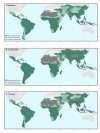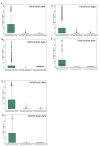The global limits and population at risk of soil-transmitted helminth infections in 2010
- PMID: 22537799
- PMCID: PMC3419672
- DOI: 10.1186/1756-3305-5-81
The global limits and population at risk of soil-transmitted helminth infections in 2010
Abstract
Background: Understanding the global limits of transmission of soil-transmitted helminth (STH) species is essential for quantifying the population at-risk and the burden of disease. This paper aims to define these limits on the basis of environmental and socioeconomic factors, and additionally seeks to investigate the effects of urbanisation and economic development on STH transmission, and estimate numbers at-risk of infection with Ascaris lumbricoides, Trichuris trichiura and hookworm in 2010.
Methods: A total of 4,840 geo-referenced estimates of infection prevalence were abstracted from the Global Atlas of Helminth Infection and related to a range of environmental factors to delineate the biological limits of transmission. The relationship between STH transmission and urbanisation and economic development was investigated using high resolution population surfaces and country-level socioeconomic indicators, respectively. Based on the identified limits, the global population at risk of STH transmission in 2010 was estimated.
Results: High and low land surface temperature and extremely arid environments were found to limit STH transmission, with differential limits identified for each species. There was evidence that the prevalence of A. lumbricoides and of T. trichiura infection was statistically greater in peri-urban areas compared to urban and rural areas, whilst the prevalence of hookworm was highest in rural areas. At national levels, no clear socioeconomic correlates of transmission were identified, with the exception that little or no infection was observed for countries with a per capita gross domestic product greater than US$ 20,000. Globally in 2010, an estimated 5.3 billion people, including 1.0 billion school-aged children, lived in areas stable for transmission of at least one STH species, with 69% of these individuals living in Asia. A further 143 million (31.1 million school-aged children) lived in areas of unstable transmission for at least one STH species.
Conclusions: These limits provide the most contemporary, plausible representation of the extent of STH risk globally, and provide an essential basis for estimating the global disease burden due to STH infection.
Figures







References
-
- Yokogawa M. 40 year history of parasite control, preventative medicine. University of Tokyo Press, Tokyo; 1993.
-
- Hsieh HC. A comparative study on worm populations (hookworm,AscarisandTrichuris) among various age-groups of rural people in south Taiwan. Tsa Chih Gaoxiong Yi Xue Yuan Tong Xue Hui. 1965;64:138–145. - PubMed
-
- Stoll NR. This Wormy World. J Parasitol. 1947;33:1–18. - PubMed
-
- Komiya Y, Kunii C. The epidemiology ofAscarisinfection in relation to its control program in Japan. Jpn J Med Sci Biol. 1964;17:23–31. - PubMed
Publication types
MeSH terms
Substances
Grants and funding
LinkOut - more resources
Full Text Sources

